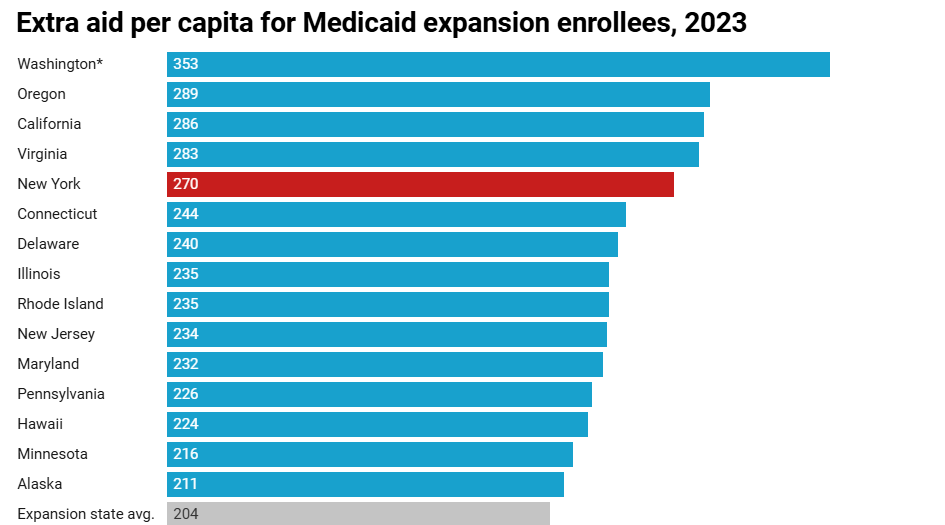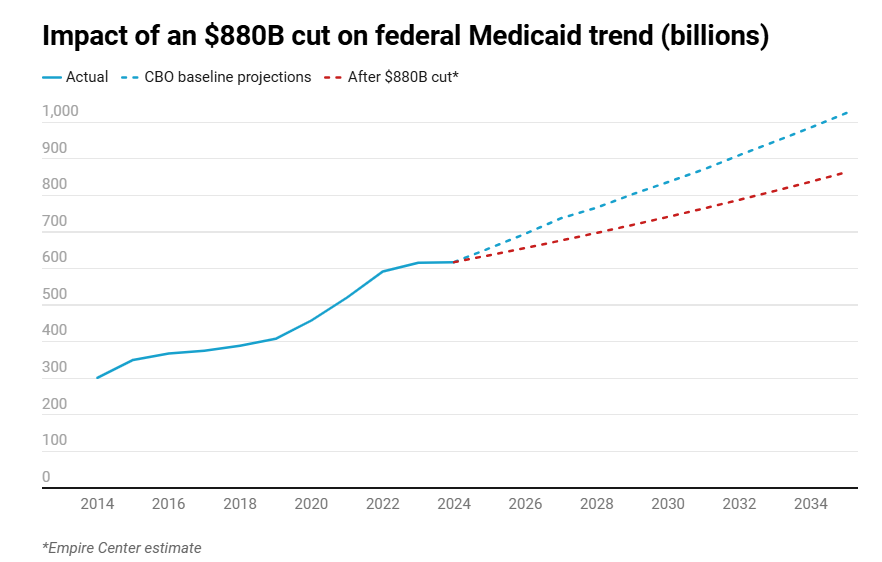New York’s Swollen Medicaid Rolls a Liability as House GOP Weighs Scaling Back Program’s Expense
The Empire State’s ‘expansion population’ — bolstered by a policy change under Obamacare — is disproportionately large.

As House Republicans consider cutbacks to federal Medicaid funding, their focus has turned to the so-called expansion population.
Although the details of these proposals remain undetermined, the stakes for New York in this debate are high. Its enrollment among the expansion population and its federal funding for those enrollees are both disproportionately large.
Medicaid’s “expansion population” refers to non-disabled adults under age 65 with incomes up to 138 percent of the federal level, which was the demographic group targeted by the Affordable Care Act’s expansion of Medicaid coverage.
New York and some others states covered much of this population prior to enactment of the ACA. However, many states offered coverage to relatively few non-disabled adults or excluded them from Medicaid entirely.
As an incentive for states to broaden their programs, ACA offered enhanced federal aid for non-disabled adults, which currently stands at 90 percent of the costs. The federal share for other enrollees ranges from 50 percent for the wealthiest states (including New York) to almost 77 percent for the poorest (Mississippi).
As the Congress seeks to slow the growth of federal Medicaid spending, its Republican leaders are considering proposals to change this policy — by, for example, phasing out the higher matching rate for expansion enrollees or establishing a growth cap on federal funding per enrollee.
As of June 2024, New York’s Medicaid program covered 2.1 million expansion adults, according to federal data. That was 11 percent of the state’s total population, the sixth-highest rate among the 41 states that joined the ACA expansion.
In 2023, New York received $15.2 billion in federal aid for expansion enrollees, the second-highest amount behind California. That aid level was $5.3 billion more than it would have been without the enhanced matching rate, also second-highest behind California. New York received $270 in extra aid per state resident, the fifth-highest amount behind Washington, Oregon, California, and Virginia (see chart below).

Based on 2023 numbers, New York would stand to lose 6 percent of its federal funding were Congress to eliminate the enhanced matching rate. It’s possible the enhanced rate would be phased out gradually, lessening the immediate effect.
The impact of a per-enrollee growth cap on expansion aid would depend heavily on how the limit is designed. In one scenario analyzed by the health-care news organization KFF, New York would stand to lose $24 billion in anticipated federal aid over 10 years.
To offset that amount, KFF estimated the state would have to increase its own Medicaid contribution by 5 percent over the same period. To put that in context, the state share of New York’s Medicaid budget has risen 36 percent over the past three years and Governor Hochul has proposed another 17 percent increase this year.
It should be kept in mind that these policy changes would be unlikely to reduce total federal Medicaid spending — or the amount flowing to New York — in absolute terms. Instead, they would slow growth compared to current trends.
As part of a larger budget-cutting plan, House leaders are seeking 10-year savings worth $880 billion from programs overseen by the Energy and Commerce Committee, most of which is expected to come out of Medicaid.
The Congressional Budget Office has estimated that federal Medicaid spending will rise at an average level of about 4.8 percent per year between 2025 and 2034. Lowering that rate of increase of 3.1 percent would be enough to save $880 billion over the 10-year period, as seen in the second chart, below.

_____________
This article appeared first on the Empire Center Blog as ‘How Medicaid “Expansion Changes” Could Affect New York.’
